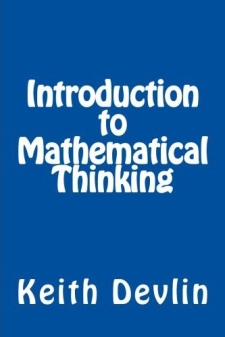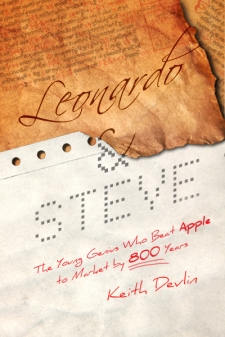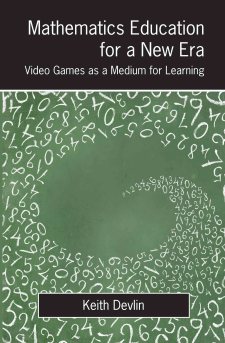Introduction to Mathematical Thinking
Keith Devlin
Learn how to think the way mathematicians do - a powerful cognitive process developed over thousands of years.MOOCtalk
Let's teach the world
Help wanted!
Published May 8, 2012 Free online courses7 CommentsTags: Coursera, distance learning, edX, Harvard University, higher education, mathematical thinking, MIT, MOOC, online education, Sebastian Thrun, Stanford University, transition course
Why am I doing this? Attempting to give a five-week, school-to-university transition course to possibly thousands of students on the Web, I mean.
I always took my teaching seriously. (When I started out university teaching in the 1970s, that was actually not a requirement for faculty; the focus was all on research. My initial appointment in the UK was as a “Lecturer”. Along with the US title of “Instructor”, those names reflected the then-expectation of what the job entailed as far as teaching was concerned.) In many years of university teaching, I always felt that as the number of students increased beyond twenty or so, the quality of the learning fell significantly. Clearly, I am not referring to lecturing — that is, providing instruction, where the students are essentially passive receivers of information. That can clearly be scaled indefinitely, through videos, and arguably that is what textbooks have always done. What can’t be scaled, is the interaction between the professor and the students — which is where a lot of the real learning takes place.
I discussed the distinction between instruction and good, interactive teaching in my March Devlin’s Angle column for the MAA. From what I read and hear all the time, I suspect that many people in the US have never experienced anything beyond instruction, at least when it comes to their mathematics education. Providing mathematics instruction (and nothing more) is like trying to eliminate starvation by providing people with fish. That alleviates the immediate hunger, but it is not a long term solution, and moreover can create a dependency on others. A far better solution is to show people how to catch fish for themselves. That is what good teaching tries to do, by trying to help students learn to think for themselves.
Mathematics is a mental activity. It is something you do. Like all activities, doing it takes effort and it makes you tired. The best way to learn how to do something is to do it. Riding a bicycle, driving a car, playing golf or tennis, skiing, playing a musical instrument, playing chess, and so on, you didn’t learn them by sitting in a classroom, listening to someone provide instruction. Of course, instruction is valuable, but only when it accompanies learning-by-doing, and is provided to the learner on demand, based on that learner’s specific needs at that instant, when it makes sense and is most readily absorbed.
A good teacher, like a good music instructor or athletics coach, begins by identifying what the student knows and can do, and then builds on that. A personal tutor can provide a complete education that way, though besides being inefficient in terms of the utilization of human expertise, one-on-one instruction suffers the significant loss of collaborative work with a small group of peers. More optimal, in my view, an experienced classroom teacher can do wonders with a class of twenty or so, split into groups of four or five for periods of collaborative work.
But with more than twenty, the dynamics change; the teacher can no longer devote sufficient time to each individual and to each group.
In my later career, when I was able to set my own class limits, I always capped at twenty (though I occasionally relented and let the number creep up by one or two, when desperate, math-requirement-short seniors pleaded to be allowed in.) So, coming back to my opening question, why on earth did I decide to try offering an online course that could attract many thousands of students, none of whom I would meet in person?
The answer was a suspicion that, with a suitable re-assessment of the goals of the course, together with a little social engineering, a different dynamic could take over. Talking to some of the Stanford professors who had given, or were giving, MOOCs, provided some anecdotal confirmation of that suspicion. So I stepped forward and volunteered to offer a five-week “transition course” this coming fall.
The purpose of transition courses is to introduce students to mathematical thinking. In the high school mathematics class, the emphasis is on mastery of procedures for solving problems. As many students discover, and as many teachers instruct them, an effective way to succeed is to approach a new problem by looking for a template — a worked example in a textbook, or these days presented on a YouTube video — and then just changing the numbers. (That is actually a valuable skill in itself, but that’s another topic.) University mathematics, on the other hand — at least the mathematics taught at university to future math and science majors — has a different goal: Learning how to think like a mathematician. And that is something most of us initially find extremely hard, and very frustrating. I’ll elaborate in future postings, but for anyone unfamiliar with the transition problem, let me give an analogy.
If we compare mathematics with the automotive world, school math corresponds to learning to drive, whereas in the automotive equivalent to college math is learning how a car works, how to maintain and repair it, and, if a student pursues the subject far enough, how to design and build their own car.
I was one of the early pioneers of transition courses back in the late 1970s, and wrote one of the first companion books, Sets, Functions, and Logic. (It was written for the UK market, but it did make it into a US edition, though many American students, used to full-service textbooks, found it hard going.) So it was a natural for me to see if, and how, the teaching of such material could be ported to the Web as a MOOC.
The benefits of doing so would, of course, be significant. Not least, high school students could attempt it prior to going to college, and college frosch taking a (physical) transition course would have a secondary source for what many find an extremely difficult transition.
The particularly fascinating part to me, as a professor, is figuring out how to take a learning experience that works in a small-group setting on a campus, and create a functionally equivalent experience online. Note that I said “create a functionally equivalent experience;” I did not say “replicate the classroom experience.”
By far the greatest problem is how to provide the personal, expert feedback that is essential to good mathematics learning. Web delivery is fine for providing instruction, but that is just a part of learning, and a minor part at that, as I discussed in that March Devlin’s Angle I referred to earlier. Taking stock of the goal and the available resources, however, there were some hopeful signs.
Because they will be supported by being part of a physical learning community, with the personal support of you, their instructor, your students will be highly empowered, privileged members of that online community. They can take advantage of your support so that they can help others. And as we all know, there is no more powerful way to learn than to try to teach others.
For that student half way round the world, perhaps working alone, trying to improve his or her life through education — by learning to think mathematically — the potential benefit is, of course, far greater. Helping that unknown young (or not so young) person make that step might just help inspire your own students to put in that bit of extra effort to master that tricky new transition material. Everyone wins.
If my Stanford MOOC draws a student body in the tens of thousands, which it might, based on the experience of my colleagues here, there is no way I and a couple of graduate TAs can provide individual feedback to every student. But if instructors and their students across the US join me, then maybe we can collectively achieve something remarkable.
I am making my MOOC deliberately short, five weeks, so participation will leave most of the semester open for participating instructors to concentrate on giving their own course, perhaps using their students’ initial experience in the MOOC community as a springboard for the rest of the course. I will make it a basic vanilla transition course, so other instructors can build on it.
Of course, you don’t have to be an instructor or a student in a transition class in order to participate. The course is totally open and free. You simply have to register (online) and start the course. So anyone who is familiar with the material — who already can think like a mathematician — can help out.
Those of us in education know how it can change lives. Growing up in a working class area of the UK in the early Post Second World War era, a free education provided by the government changed mine. Now, through technology, I can return the favor by helping others around the world change theirs. Please join me this fall as we learn how to teach the world.
I always took my teaching seriously. (When I started out university teaching in the 1970s, that was actually not a requirement for faculty; the focus was all on research. My initial appointment in the UK was as a “Lecturer”. Along with the US title of “Instructor”, those names reflected the then-expectation of what the job entailed as far as teaching was concerned.) In many years of university teaching, I always felt that as the number of students increased beyond twenty or so, the quality of the learning fell significantly. Clearly, I am not referring to lecturing — that is, providing instruction, where the students are essentially passive receivers of information. That can clearly be scaled indefinitely, through videos, and arguably that is what textbooks have always done. What can’t be scaled, is the interaction between the professor and the students — which is where a lot of the real learning takes place.
I discussed the distinction between instruction and good, interactive teaching in my March Devlin’s Angle column for the MAA. From what I read and hear all the time, I suspect that many people in the US have never experienced anything beyond instruction, at least when it comes to their mathematics education. Providing mathematics instruction (and nothing more) is like trying to eliminate starvation by providing people with fish. That alleviates the immediate hunger, but it is not a long term solution, and moreover can create a dependency on others. A far better solution is to show people how to catch fish for themselves. That is what good teaching tries to do, by trying to help students learn to think for themselves.
Mathematics is a mental activity. It is something you do. Like all activities, doing it takes effort and it makes you tired. The best way to learn how to do something is to do it. Riding a bicycle, driving a car, playing golf or tennis, skiing, playing a musical instrument, playing chess, and so on, you didn’t learn them by sitting in a classroom, listening to someone provide instruction. Of course, instruction is valuable, but only when it accompanies learning-by-doing, and is provided to the learner on demand, based on that learner’s specific needs at that instant, when it makes sense and is most readily absorbed.
A good teacher, like a good music instructor or athletics coach, begins by identifying what the student knows and can do, and then builds on that. A personal tutor can provide a complete education that way, though besides being inefficient in terms of the utilization of human expertise, one-on-one instruction suffers the significant loss of collaborative work with a small group of peers. More optimal, in my view, an experienced classroom teacher can do wonders with a class of twenty or so, split into groups of four or five for periods of collaborative work.
But with more than twenty, the dynamics change; the teacher can no longer devote sufficient time to each individual and to each group.
In my later career, when I was able to set my own class limits, I always capped at twenty (though I occasionally relented and let the number creep up by one or two, when desperate, math-requirement-short seniors pleaded to be allowed in.) So, coming back to my opening question, why on earth did I decide to try offering an online course that could attract many thousands of students, none of whom I would meet in person?
The answer was a suspicion that, with a suitable re-assessment of the goals of the course, together with a little social engineering, a different dynamic could take over. Talking to some of the Stanford professors who had given, or were giving, MOOCs, provided some anecdotal confirmation of that suspicion. So I stepped forward and volunteered to offer a five-week “transition course” this coming fall.
The purpose of transition courses is to introduce students to mathematical thinking. In the high school mathematics class, the emphasis is on mastery of procedures for solving problems. As many students discover, and as many teachers instruct them, an effective way to succeed is to approach a new problem by looking for a template — a worked example in a textbook, or these days presented on a YouTube video — and then just changing the numbers. (That is actually a valuable skill in itself, but that’s another topic.) University mathematics, on the other hand — at least the mathematics taught at university to future math and science majors — has a different goal: Learning how to think like a mathematician. And that is something most of us initially find extremely hard, and very frustrating. I’ll elaborate in future postings, but for anyone unfamiliar with the transition problem, let me give an analogy.
If we compare mathematics with the automotive world, school math corresponds to learning to drive, whereas in the automotive equivalent to college math is learning how a car works, how to maintain and repair it, and, if a student pursues the subject far enough, how to design and build their own car.
I was one of the early pioneers of transition courses back in the late 1970s, and wrote one of the first companion books, Sets, Functions, and Logic. (It was written for the UK market, but it did make it into a US edition, though many American students, used to full-service textbooks, found it hard going.) So it was a natural for me to see if, and how, the teaching of such material could be ported to the Web as a MOOC.
The benefits of doing so would, of course, be significant. Not least, high school students could attempt it prior to going to college, and college frosch taking a (physical) transition course would have a secondary source for what many find an extremely difficult transition.
The particularly fascinating part to me, as a professor, is figuring out how to take a learning experience that works in a small-group setting on a campus, and create a functionally equivalent experience online. Note that I said “create a functionally equivalent experience;” I did not say “replicate the classroom experience.”
By far the greatest problem is how to provide the personal, expert feedback that is essential to good mathematics learning. Web delivery is fine for providing instruction, but that is just a part of learning, and a minor part at that, as I discussed in that March Devlin’s Angle I referred to earlier. Taking stock of the goal and the available resources, however, there were some hopeful signs.
First, the whole MOOC concept finally took off late last year (with Sebastian Thrun’s Stanford AI course) largely because Stanford and the now independent spinoff company Coursera built innovative new platforms. (Just last week, MIT and Harvard announced that they too were launching their own platform, edX.) Listening to some of my Stanford colleagues describe their experiences giving their first-generation MOOCs, I began to see the opportunities the new platforms (which are still under development) offer.
I’ll examine some of the affordances the new learning medium provides in future postings. (I’m still learning myself.) In the meantime, I need to assemble a small army of volunteers. This is where I’ll need help — possibly your help.
One of the things we’ve learned already about MOOCs, is that a key component is the creation of a strong online community. Learning is all about human interaction. The technology just provides the medium for that interaction. In offering my math transition MOOC at the start of the fall term, when many colleges and universities offer their own transition course, I am inviting any instructor who will be giving such a course, together with their students, to join me and my MOOC students online, making interaction with other students around the world a part of a much larger learning community.
In my May Devlin’s Angle post, I put out a first call for involvement of my fellow MAA members. Here, in summary, is what I wrote there.
I’m going to make my course just five weeks long, starting in early October. By incorporating participation in my Stanford course as part of your students’ learning experience, everyone could benefit. For one thing, your students are likely to be inspired by being part of an educational revolution that for millions of less privileged people around the globe can quite literally be life changing.Because they will be supported by being part of a physical learning community, with the personal support of you, their instructor, your students will be highly empowered, privileged members of that online community. They can take advantage of your support so that they can help others. And as we all know, there is no more powerful way to learn than to try to teach others.
For that student half way round the world, perhaps working alone, trying to improve his or her life through education — by learning to think mathematically — the potential benefit is, of course, far greater. Helping that unknown young (or not so young) person make that step might just help inspire your own students to put in that bit of extra effort to master that tricky new transition material. Everyone wins.
If my Stanford MOOC draws a student body in the tens of thousands, which it might, based on the experience of my colleagues here, there is no way I and a couple of graduate TAs can provide individual feedback to every student. But if instructors and their students across the US join me, then maybe we can collectively achieve something remarkable.
I am making my MOOC deliberately short, five weeks, so participation will leave most of the semester open for participating instructors to concentrate on giving their own course, perhaps using their students’ initial experience in the MOOC community as a springboard for the rest of the course. I will make it a basic vanilla transition course, so other instructors can build on it.
Of course, you don’t have to be an instructor or a student in a transition class in order to participate. The course is totally open and free. You simply have to register (online) and start the course. So anyone who is familiar with the material — who already can think like a mathematician — can help out.
Those of us in education know how it can change lives. Growing up in a working class area of the UK in the early Post Second World War era, a free education provided by the government changed mine. Now, through technology, I can return the favor by helping others around the world change theirs. Please join me this fall as we learn how to teach the world.
7 Responses to “Help wanted!”
Comments are currently closed.






At the very least I plan to enroll as one of your students. I’m fascinated by how we might effectively use the web to create a dynamic and interactive learning experience for students. iTunes U is really just a “push” platform; I’m curious how that idea might be hacked to create a more networked platform. It seems to me that’s the sort of thing you’re exploring with this MOOC.
As a math teacher/student in your class I’m curious to watch the evolution of math pedagogy in this environment. That, and I’m a long time fan.